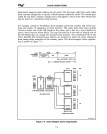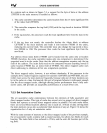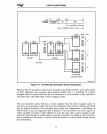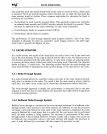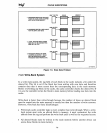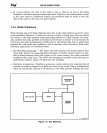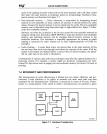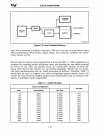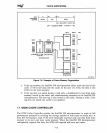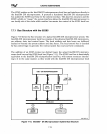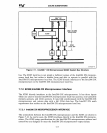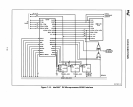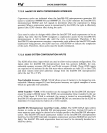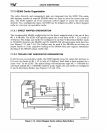
CACHE SUBSYSTEMS
7.5 CACHE
AND
DMA
Cache coherency
is
an issue
one
must consider when placing a
DMA
controller in an
Intel386
DX
microprocessor system. Because the
DMA
controller has access to main
memory, it can potentially introduce stale data. As was mentioned before, stale data can
be avoided in the following
ways:
o Implementing bus watching (snooping).
In
this approach, the
DMA
controller writes
to main memory, and the cache controller monitors
DMA
cycles and automatically
invalidates any cache location altered
by
DMA.
o Implementing a transparent cache, in which memory accesses from both the
Inte1386
DX
microprocessor and the DMA controller are directed through the cache.
• Restrict
DMA
cycles to non-cacheable areas of memory.
The first method has a distinct advantage: since the
DMA
controller does not access the
cache directly, the Intel386
DX
microprocessor can read from the cache while the
DMA
controller
is
moving data to the main memory. Although bus watching
is
difficult to
implement in a discrete cache design, the 82385 integrates this function and performs
zero waitstate bus watching. The overall memory bandwidth
is
increased since the
Intel386
DX
microprocessor can access its cache at the same time
as
the DMA control-
ler accesses main memory.
The second approach has the advantage of requiring minimal hardware,
but
has the
disadvantage that the Intel386
DX
microprocessor must
be
placed in HOLD during
DMA
transfers. The third approach
is
useful if a separate, dual-ported memory can be
used
as
the non-cache able memory, and the
DMA
device
is
tightly coupled to this mem-
ory.
In
all approaches, the cache should
be
made software transparent,
so
that
DMA
cycles do not require special actions
by
software to insure cache coherency.
7.6 CACHE EXAMPLE
The cache system example described in this section illustrates some of the decisions a
cache designer must make. The requirements of a particular system may result in differ-
ent choices than the ones made here. However, the issues presented in this section will
arise in the process
of
designing any cache system.
7.6.1 Example Design
The cache system uses a direct-mapped
cache.
In previous generations
of
computers, it
was often practical to build a 2-way
or
4-way associative cache. SRAMs had
low
memory
capacity,
so
many of them were needed to construct a cache of reasonable size. However,
today's SRAMs are more dense, cost less, and take up less space.
It
is
now
more eco-
nomical to increase cache efficiency
by
increasing cache size (SRAMs) rather than asso-
ciativity (control logic and comparators).
7-13



